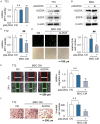Anticancer peptides from induced tumor-suppressing cells for inhibiting osteosarcoma cells
- PMID: 37818062
- PMCID: PMC10560922
Anticancer peptides from induced tumor-suppressing cells for inhibiting osteosarcoma cells
Abstract
Osteosarcoma (OS) is the most frequent primary bone cancer, which is mainly suffered by children and young adults. While the current surgical treatment combined with chemotherapy is effective for the early stage of OS, advanced OS preferentially metastasizes to the lung and is difficult to treat. Here, we examined the efficacy of ten anti-OS peptide candidates from a trypsin-digested conditioned medium that was derived from the secretome of induced tumor-suppressing cells (iTSCs). Using OS cell lines, the antitumor capabilities of the peptide candidates were evaluated by assaying the alterations in metabolic activities, proliferation, motility, and invasion of OS cells. Among ten candidates, peptide P05 (ADDGRPFPQVIK), a fragment of aldolase A (ALDOA), presented the most potent OS-suppressing capabilities. Its efficacy was additive with standard-of-care chemotherapeutic agents such as cisplatin and doxorubicin, and it downregulated oncoproteins such as epidermal growth factor receptor (EGFR), Snail, and Src in OS cells. Interestingly, P05 did not present inhibitory effects on non-OS skeletal cells such as mesenchymal stem cells and osteoblast cells. Collectively, this study demonstrated that iTSC-derived secretomes may provide a source for identifying anticancer peptides, and P05 may warrant further evaluations for the treatment of OS.
Keywords: ALDOA; EGFR; Osteosarcoma; induced tumor-suppressing cells; peptide.
AJCR Copyright © 2023.
Conflict of interest statement
None.
Figures







Similar articles
-
P18: Novel Anticancer Peptide from Induced Tumor-Suppressing Cells Targeting Breast Cancer and Bone Metastasis.Cancers (Basel). 2024 Jun 15;16(12):2230. doi: 10.3390/cancers16122230. Cancers (Basel). 2024. PMID: 38927935 Free PMC article.
-
Anticancer Peptides Derived from Aldolase A and Induced Tumor-Suppressing Cells Inhibit Pancreatic Ductal Adenocarcinoma Cells.Pharmaceutics. 2023 Oct 11;15(10):2447. doi: 10.3390/pharmaceutics15102447. Pharmaceutics. 2023. PMID: 37896207 Free PMC article.
-
Osteosarcoma-enriched transcripts paradoxically generate osteosarcoma-suppressing extracellular proteins.Elife. 2023 Mar 21;12:e83768. doi: 10.7554/eLife.83768. Elife. 2023. PMID: 36943734 Free PMC article.
-
The Fas/FasL Signaling Pathway: Its Role in the Metastatic Process and as a Target for Treating Osteosarcoma Lung Metastases.Adv Exp Med Biol. 2020;1258:177-187. doi: 10.1007/978-3-030-43085-6_12. Adv Exp Med Biol. 2020. PMID: 32767242 Review.
-
The Double-Edged Proteins in Cancer Proteomes and the Generation of Induced Tumor-Suppressing Cells (iTSCs).Proteomes. 2023 Jan 18;11(1):5. doi: 10.3390/proteomes11010005. Proteomes. 2023. PMID: 36810561 Free PMC article. Review.
Cited by
-
Biological Activity of Natural and Synthetic Peptides as Anticancer Agents.Int J Mol Sci. 2024 Jul 1;25(13):7264. doi: 10.3390/ijms25137264. Int J Mol Sci. 2024. PMID: 39000371 Free PMC article. Review.
-
Unveiling the Dichotomy of Urinary Proteins: Diagnostic Insights into Breast and Prostate Cancer and Their Roles.Proteomes. 2023 Dec 26;12(1):1. doi: 10.3390/proteomes12010001. Proteomes. 2023. PMID: 38250812 Free PMC article. Review.
-
P18: Novel Anticancer Peptide from Induced Tumor-Suppressing Cells Targeting Breast Cancer and Bone Metastasis.Cancers (Basel). 2024 Jun 15;16(12):2230. doi: 10.3390/cancers16122230. Cancers (Basel). 2024. PMID: 38927935 Free PMC article.
References
-
- Harrison DJ, Geller DS, Gill JD, Lewis VO, Gorlick R. Current and future therapeutic approaches for osteosarcoma. Expert Rev Anticancer Ther. 2018;18:39–50. - PubMed
-
- Kager L, Tamamyan G, Bielack S. Novel insights and therapeutic interventions for pediatric osteosarcoma. Future Oncol. 2017;13:357–368. - PubMed
Grants and funding
LinkOut - more resources
Full Text Sources
Other Literature Sources
Research Materials
Miscellaneous
